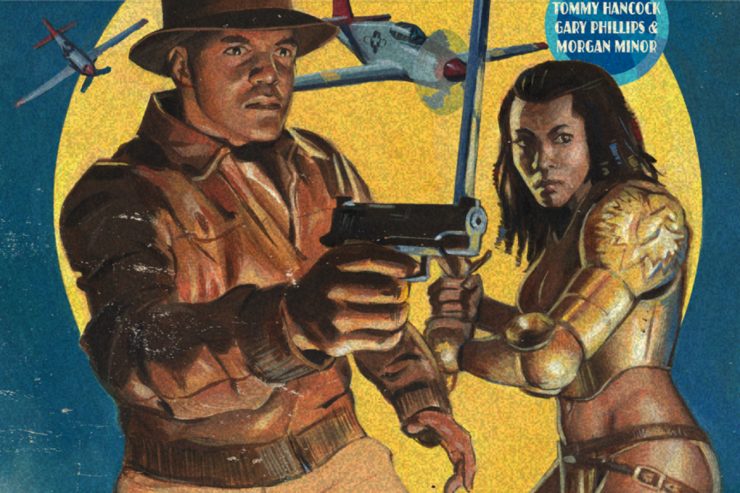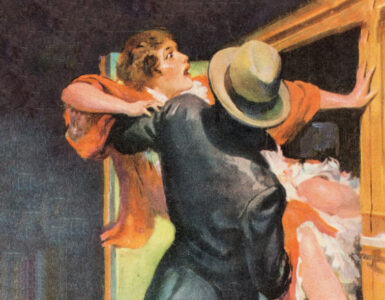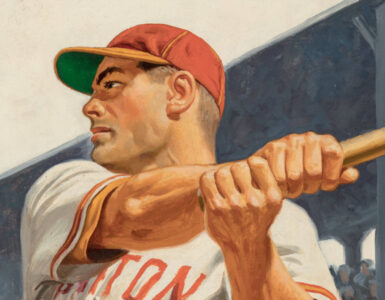Pulp magazines have influenced writers, artists, film directors, software developers, and countless others over the years. Our “PulpFest Profiles” focus on contemporary creators who have drawn inspiration from these rough-paper fiction magazines.
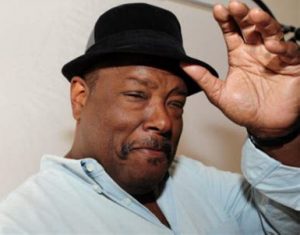 As award-winning author Gary Phillips remembers it, his love of all things pulp started with a decidedly non-traditional take on a classic pulp character: the Belmont series of Shadow paperback originals written by Dennis Lynds and published from 1964 – 1967.
As award-winning author Gary Phillips remembers it, his love of all things pulp started with a decidedly non-traditional take on a classic pulp character: the Belmont series of Shadow paperback originals written by Dennis Lynds and published from 1964 – 1967.
After a 1963 standalone classic throwback novel, Return of The Shadow, penned by original Shadow-master “Maxwell Grant” (at last writing under his own name of Walter B. Gibson), Belmont changed course and authors. It was the height of 007-inspired spy mania, and The Shadow and his cadre of agents were reimagined as operatives more in the vein of The Man From U.N.C.L.E.
“It’s funny, I met him years later — a lovely man, Dennis Lynds,” Gary recalls. “He wrote under a number of aliases, including Michael Collins. He was mostly a mystery writer. It was in the Sixties when they revived The Shadow, and he worked for this organization. I met Dennis years later and then I found out he had written The Shadows. Somehow, I stumbled on those and that definitely got me on the path. I’ve still got a couple of them. There was one — The Shadow, Destination: Moon — where the Shadow is holding a TV, and the TV is held out to us — the audience — and you see a rocket blasting off. It had to do with espionage. It was like they were taking The Shadow, and making him a little like James Bond.”
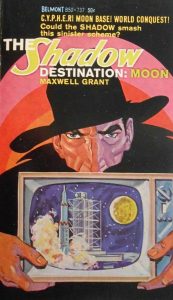
About the time The Shadow was being altered by Belmont, another paperback publisher was reviving his Street and Smith stablemate, Doctor Clark Savage, Jr.
In Doc’s case, he got a makeover and new hairdo, but in terms of content, Bantam Books opted to reprint the original pulp tales virtually unchanged.
Gary recalls, “Way back at the dawn of time, when I was a young man going to high school — that would have been the seventies — in those days Bantam was reprinting Doc Savage in paperback form with those great James Bama covers, which is what I think attracted me and certainly plenty of others to him. I hadn’t heard of Doc Savage, but I knew something about the old pulps. Maybe because I had already at that point acquired a couple of the old Street and Smith Shadow pulps. So I got hooked on Doc Savage; I would carry it in my back pocket on my way to football practice. That’s how it all really began.”
In the 1970s, he says, “I had one foot in the pulp camp, but I was already starting to read Chandler, Hammett, and Ross Macdonald, as well.”
The seventies also saw the return of another Street & Smith pulp hero, The Avenger, whose adventures were reprinted by Warner Books. This was another pulp series that Gary Phillips latched onto.
After reported input from Doc Savage’s Lester Dent and The Shadow’s Gibson, The Avenger pulps were penned by Paul Ernst, writing under the house name of “Kenneth Robeson.”
The Avenger series, though briefly lived, is notable in that two of the title character’s aides — Josh and Rosabel Newton — are not just man and wife, but of color.
When Warner exhausted the original Avenger pulp novel run, the series continued on a while, penned by the recently deceased Ron Goulart.
Phillips also devoured Goulart’s Avenger continuations.
In 2008, Moonstone published a collection of new Avenger short stories, The Avenger Chronicles. One of those stories is penned by Gary, and the characters of Josh and Rosabel are very much front-and-center in “The Freeze Devil.”
As he continues to intersperse his own crime fiction with neo-pulp and vintage pulp character-inspired works, one wonders what it is about this classic and squarely American pulp fiction genre that still informs so much of Gary Phillips’ work this deep into the 21st Century.
Gary explains, “It’s an interesting question. It’s that moving target — sort of like when people talk about ‘What’s noir,’ right? We define pulp as being fast-paced and fast-moving and certainly plot-driven. There is that. But certainly now as we have gotten into the new pulp era and retro-pulp, it’s driven more by characterization. There’s a lot of overlap between them, but between my pulp fiction work and crime writing, I’ve always been attracted to intricate and interesting plotting. That’s one of the things that has always attracted me to the form.”
That said, much of Phillips’s own pulp-inflected works — from his Avenger short fiction to his 2020 rather Doc Savage-suggestive novel, Matthew Henson and the Ice Temple of Harlem (Agora Books) — have been period pieces.
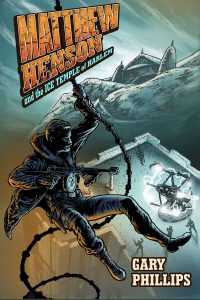 The Ice Temple of Harlem takes the historical North Pole explorer Henson and drops him into the thick of the Harlem Renaissance. It’s a novel that’s a little like a pulp-inflected spin on E. L. Doctorow’s Ragtime, with real-life characters cropping up in name or in person, including Nikola Testa, Dashiell Hammett, and Dutch Schultz. There is also a character named “Hugo Renwick” in a winking tribute to big-fisted Doc Savage aide, “Renny” Renwick.
The Ice Temple of Harlem takes the historical North Pole explorer Henson and drops him into the thick of the Harlem Renaissance. It’s a novel that’s a little like a pulp-inflected spin on E. L. Doctorow’s Ragtime, with real-life characters cropping up in name or in person, including Nikola Testa, Dashiell Hammett, and Dutch Schultz. There is also a character named “Hugo Renwick” in a winking tribute to big-fisted Doc Savage aide, “Renny” Renwick.
“It’s part of the charm — going back, but also redefining it,” Gary explained. “Certainly in the Matthew Henson novel, you’re looking at it from a Black man’s point of view in the late twenties. And of course, as we certainly all know, that wasn’t particularly afforded in terms of those days in pulp fiction. There were some Black characters who had shown up — certainly within the Avenger series, and Jericho Druke in The Shadow. That’s one of the things — taking those things from the past and looking at them through that different lens. But it is certainly the case too that I’ve written some short stories that would be considered more pulp-influenced but in a modern setting.
“But again, these lines start to blur,” he continues. “When you’re writing superhero stuff, certainly superheroes sprang from the pulps, so a lot of that stuff becomes somewhat interchangeable in the sense of the sensibilities of (the material). There’s something to be said for a retro look at the past, but there are plenty of pulp things happening in today’s world.”
By way of example, Gary cited the award-winning anthology he edited entitled The Obama Inheritance: Fifteen Stories of Conspiracy Noir (Three Rooms Press, 2017).

“I told everybody, ‘Just take any crazy, insane notion that’s out there about Obama and just have fun with it. Let’s have lizard people. Let’s have time travel. Let’s do all that stuff.’ You can’t get more pulp than that.”
As Gary has pointed out, race and racial identity are strongly running currents through much of his period and neo-pulp works. As he also allows, the original pulp tales can be problematic in some of these areas as works of their time.
Asked if he revisits much of vintage pulp these days, and how he evaluates or processes those works from a contemporary perspective, he says: “An interesting question. It’s funny you ask that. But I was listening to “Fortress of Solitude” (Doc Savage, October 1938) on audio not too long ago. I appreciate what Dent was doing and that kind of style. It certainly did have an influence on me. It’s not like I’m ignoring the past, or I’m not reading that stuff. It’s just time constraints and everything else gets in there.”
That said, in preparation for an unidentified project he describes as “much-much pulp influenced,” Gary says, “I’ve been reading a guy’s early stuff. This is a guy who did a lot of stuff for Black Mask. And you’re right, some of that stuff doesn’t hold up real well. I don’t mean for the racial stuff, but for the time period, the style, and the approach to the work. You think, ‘For the time period they did what they did, and some of those guys understood it.’ Hammett kind of looked at it and hammered it out and some of that stuff stands up. There’s a reason that The Maltese Falcon is a template for the modern P. I. novel. Maybe not so much now, but at a certain point everything was kind of riffing on that. Some of it has gone by the wayside, but the influence of that writing still exists. Look at the revamped Perry Mason, where you go back and take the character and show what made this guy. We’re going to take these noir tropes that in a lot of ways came out of the pulps and shade this character in a different way than he was presented before.”
Gary insists vintage pulp fiction still has valuable lessons to teach present-day fiction writers.
“It’s part of this continuum, of this discussion about, ‘Is it plot or is it character that drives the work?’ What is it that predominates? In the old pulps, as we’ve discussed, it’s plot. Plot drove and drove and drove. But even then, there were spots where you slowed down and you started to get some insights into Doc Savage. You certainly got some psychological insights into The Shadow from Gibson. I think the lesson I take away and certainly try to apply in my own work, whether it’s new-pulp or crime fiction, is that plot and character can go hand-in-hand. At times, we do want to slow down. We do want to stop and give you some insight into the character, but there are things that can happen in the plot, as we know, that can help to illuminate character, to help define it.”
What’s next for Gary Phillips?
He’s entertained ideas of some more works featuring Matthew Henson, either in prose or graphic novel format.
“There was some intention on my part to do a Matthew Henson graphic novel. It had to do with Henson coming out to California and he hooks up with Josephine Baker and it kind of got sidetracked. I’ve got to get to it. I would love to do an old-fashioned-pulp style work with prose, but some spot illustrations scattered throughout.”
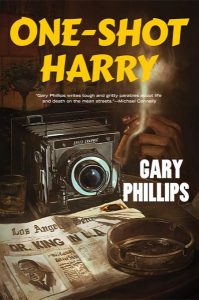 He will also be moving back into the crime fiction world with a new character and series. “The first book will be out from Soho this April, set in 1963 L.A. It’s about a crime photographer character who is kind of a combination of Weegee — the photographer and photojournalist known for his stark black and white street photography in New York City — as well as a black photographer here in town (Los Angeles) named Harry Adams. My character is named Harry Ingram. The publisher liked it and we’re getting some nice advance word on it. So I’m slowly but surely working on the next novel.”
He will also be moving back into the crime fiction world with a new character and series. “The first book will be out from Soho this April, set in 1963 L.A. It’s about a crime photographer character who is kind of a combination of Weegee — the photographer and photojournalist known for his stark black and white street photography in New York City — as well as a black photographer here in town (Los Angeles) named Harry Adams. My character is named Harry Ingram. The publisher liked it and we’re getting some nice advance word on it. So I’m slowly but surely working on the next novel.”
He adds, “In terms of pulp stuff, there’s a couple of things waiting in the wings. In particular, I’ve written a short story with my Decimator Smith character who was in Black Pulp I and II. Like Doc Savage, he’s a public hero though his stories are set In 1930s L. A., a territory not often depicted in the pulp era. In this third outing, he teams up with Jim Anthony, Super-Detective. It’s going to be in an anthology of such stories from Moonstone.
“I’m also percolating another idea. I won’t say what it is yet. I have several other pulp and neo-pulp characters that I’m going to try and get into some kind of graphic novel or form of team-up, but that’s probably a little further down the line.”
In addition to The Avenger, Jim Anthony, and The Spider, are there other classic pulp heroes Gary would like to tackle?
“It would be the big two, the Grail — The Shadow and Doc Savage,” he says. “Probably that will never happen, but Lord knows, I would love to do that.”
Gary Phillips was born and raised in Los Angeles many moons ago, the son of a mechanic and a librarian. Early on he was influenced by the works of Arthur Conan Doyle, Dashiell Hammett, Richard Wright, Rod Serling, comic book artists Jack Kirby and Jim Aparo, Zora Neale Hurston, Donald Goines, and Lester Dent. The author of twenty-two novels, more than seventy short stories, and various comic book miniseries, Phillips is on the board of the Southern California Chapter of the Mystery Writers of America, and a member of the Los Angeles Chapter of Sisters in Crime, The Private Eye Writers of America, the International Thriller Writers, and the North American Branch of the International Association of Crime Writers.
Gary’s work has appeared in Black Pulp — Pro Se Press, 2013 — with cover art by Adam Benet Shaw, and The Avenger Chronicles — Moonstone, 2008 — with cover art by Peter Caras. His novels include Matthew Henson and the Ice Temple of Harlem — Agora Books, 2020 — with cover art by Chuck Regan, and One-Shot Harry — forthcoming from Soho Crime — with cover art by Fay Dalton. Phillips also edited The Obama Inheritance — Three Rooms Press, 2017 — with cover art by Rich Trask. His interest in pulp fiction began with the Dennis Lynds Shadow novel, Destination: Moon, published by Belmont Books in 1967. The cover artist is not credited.
To learn more about Gary and his work, please visit his official website at gdphillips.com.
The author of the Edgar-nominated Hector Lassiter historical crime series, Craig McDonald is an award-winning novelist, journalist, and editor. His series chronicles the exploits of a fictional Black Mask author and his encounters with such notable figures as Ernest Hemingway, Orson Welles, Ian Fleming, and Lester Dent. In addition to his Edgar nomination, Craig was also a finalist for the Anthony, Gumshoe, and Crimespree Magazine award for best first novel.

